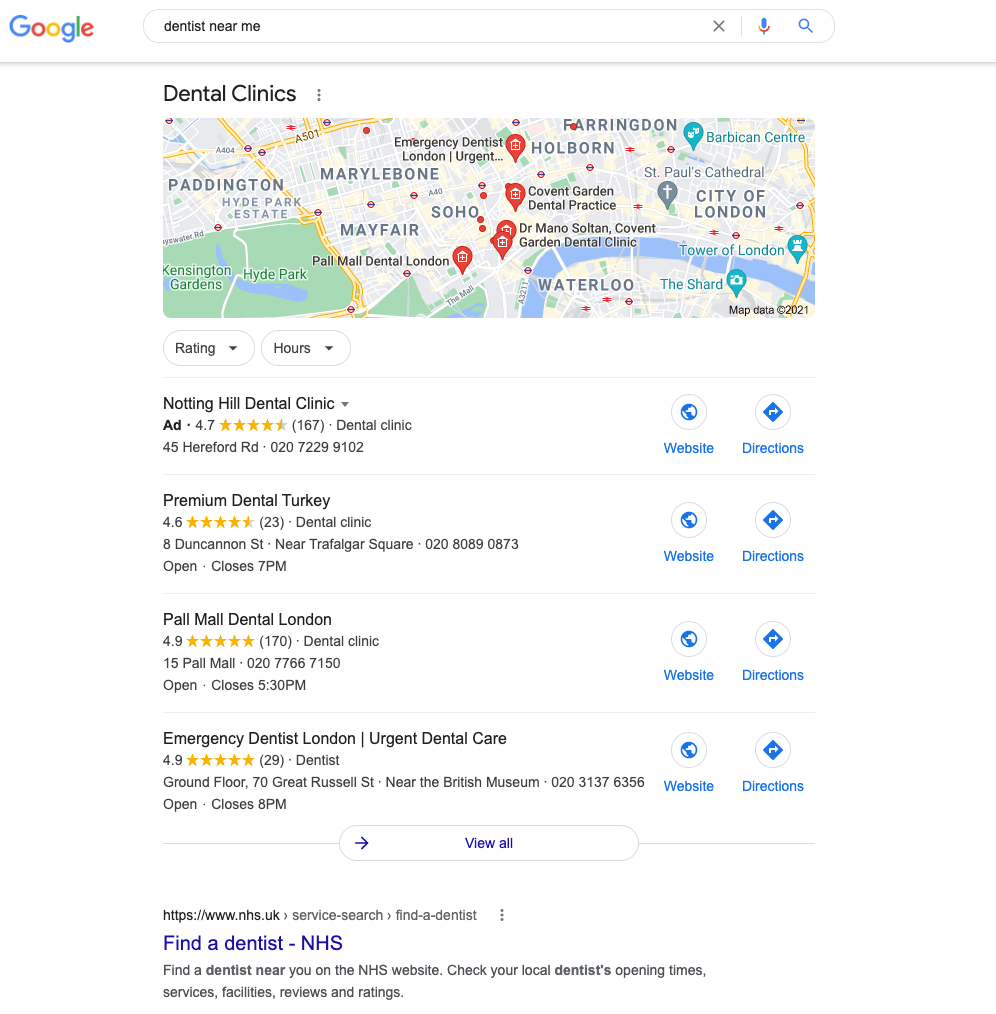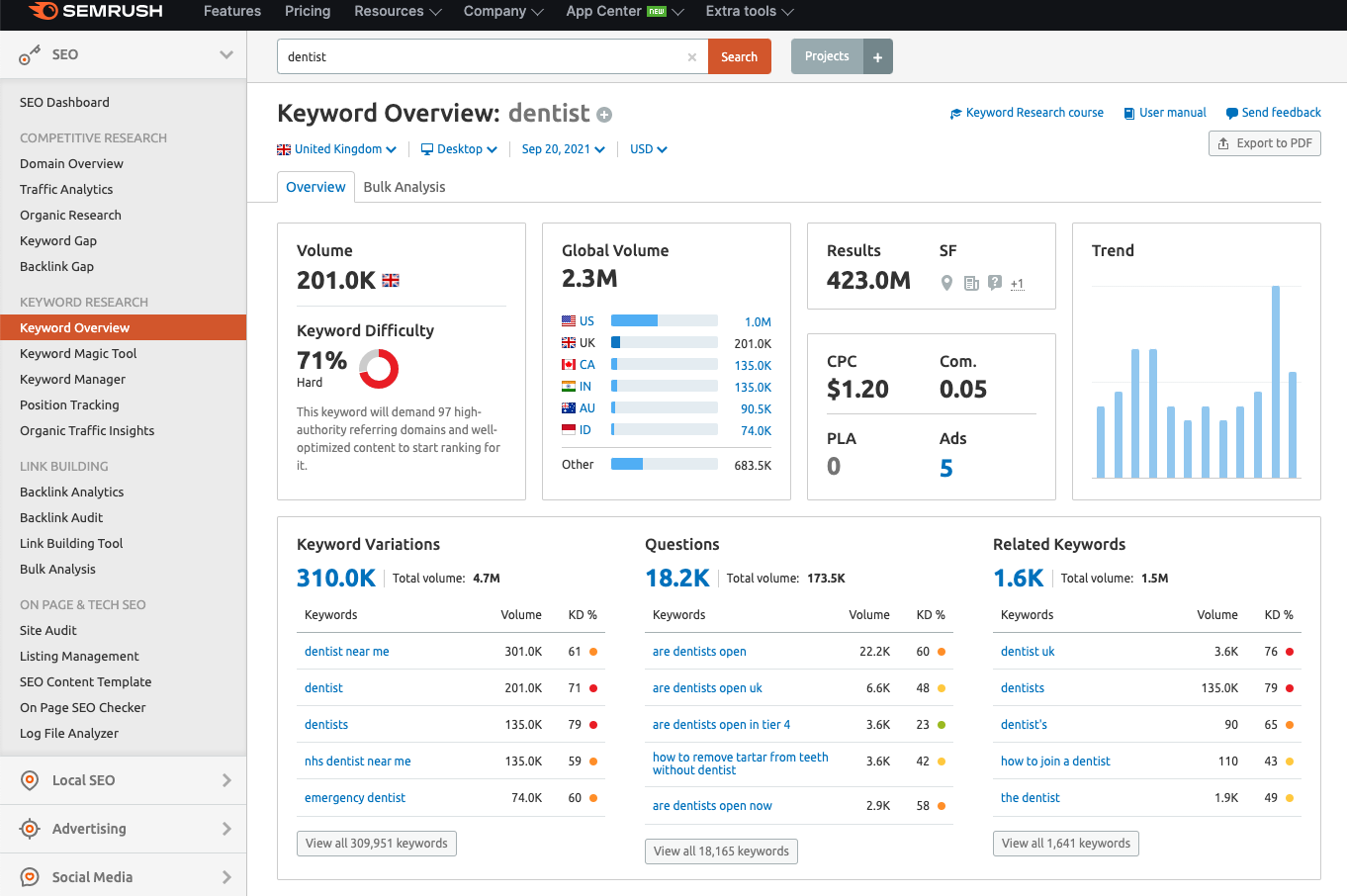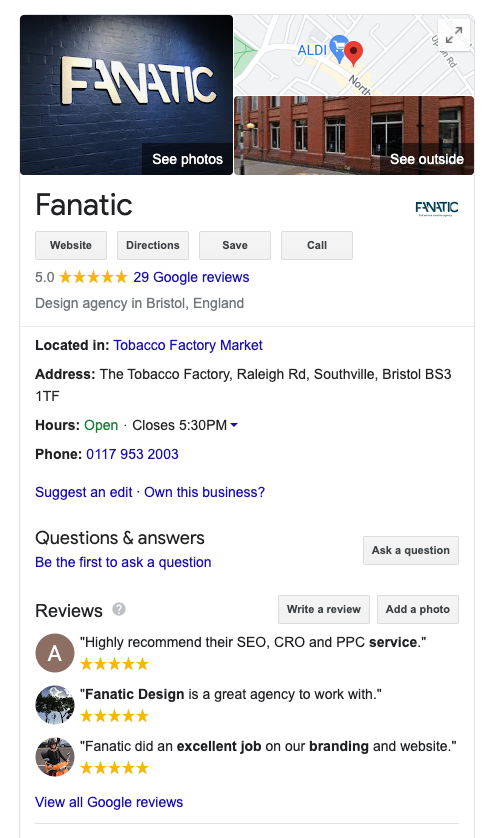September 21, 2021
Creating an efficient local SEO strategy and executing it well can be a very challenging and time-consuming task. To help you succeed, we’ve put together a comprehensive local SEO guide to give you some structure, guide your efforts, and answer all the local SEO questions you may have. The steps in this article can help you create and optimise a strategy that will attract and gain local customers from your target audience.
But before we move to the first step of our guide, let’s make something clear; what is local SEO exactly?
Google realised from early on that when users are searching for certain types of businesses, products, or services, they need results from their immediate area. Therefore, when someone performs an online search to look for a local business like a doctor, a pharmacy, or a fast-food restaurant, Google’s local search algorithm includes a proximity factor and is using the user’s location based on IP address (for desktop) and geolocation (for mobile) to display relevant local businesses. This happens even when the user doesn’t include a city name or the words “near me” in their search.
Local search is not a new thing. It has been around for many years. Nevertheless, it was pretty limited until a few years ago as people were only using their desktop computers to perform online searches. With the recent growth in mobile internet access, though, mobile search has skyrocketed, and as a result, optimising a website for local search has become paramount for the success of any business offering local products or services. And that’s where local SEO comes into play.
Local SEO is a search engine optimisation strategy to increase your business’ visibility in local search results on Google and other search engines. More specifically, local SEO is the process of optimising a website, product, or service for a search query that is location-specific. Any business that has a physical location or serves a specific geographic area can benefit from local SEO.
Around 46% of the searches on Google have local intent, and when people perform local searches, there’s typically a much higher intent to purchase, and therefore, a higher conversion rate. That makes it very clear that if you can get your local business in front of these searches, there’s a very good chance customers will be walking through your door a few minutes later.
And don’t worry, you won’t have to learn a whole new set of techniques if you’re already familiar with SEO; local SEO isn’t all that different. All the core tenets of SEO apply. Keyword research, content, links, on-page technical SEO are all there but with a local focus.
That being said, what differentiates local from SEO is that Google uses an additional set of ranking factors to rank the local search results like:
Now that you have a better understanding of what local SEO is, it’s time to move to the first step of our guide: your Google My Business account.
It’s common practice for businesses to create a Google business listing, also known as a Business Profile, to gain more visibility on Google. Business Profiles appear in Google Maps and in the local results of Google Search and can be an instrumental SEO and lead generation tool. Your Business Profile will be open to consumers to leave reviews, add photos, ask and answer questions, and more. Your Business Profile may also get populated with relevant information that Google pulls in from across the web.
Nevertheless, to manage and edit your business profile, you must also create a Google My Business account for your profile. Google My Business is a free and easy-to-use tool that allows businesses to manage their online presence across Google, including Local Search and Maps.
Business Profiles on Google Search look like this:

If you set up and optimise your Google My Business account properly, your business can show as part of a set of local businesses with a map of their locations pulled from Google Maps called the Map Pack (also known as “The Local Pack”). And the best part? The Map Pack will show above any organic result (but still below the paid results).
Your Business Profile alone contains limited information about your business. But through your Google My Business account dashboard, you can provide opening hours, a link to your website, products and pricing, attributes, and any other details that will highlight what makes your business unique. So, it’s critical to provide as much information as possible.
When creating your Google My Business account, Google provides you with a score for how complete your profile is. We suggest you use that score merely as a baseline since it covers just the primary fields of your account.
Filling more fields can have a big impact on the keywords your business can rank for. For example, besides the top-level category that describes your business, which is a mandatory field, we suggest you include secondary categories that describe what your business does in more detail. It’s also crucial to fill the ‘Services’ and ‘Products’ fields under the ‘Info’ tab to highlight what your business is actually selling and include as many relevant keywords as possible in your business description.
Last but not least, you can make your local listings more eye-catching by uploading high-resolution images and videos on your Google My Business profile that showcase your product or services. And don’t forget to tag them with geotags and include relevant keywords in their alt text and captions.
When it comes to Google My Business, consistency is paramount. Not only should everything you enter into your Google My Business account match your website, but it should also match your NAP citations around the web. Any inconsistencies can be a huge red flag. If Google can’t determine which information about your business is correct, it may not show your business at all in local search results.
Consequently, if your business changes its name, physical location, or phone number, you should immediately update your Google My Business account and any citations on local business directories. Additionally, make sure to remove any duplicate listings you find.
There are many ways consumers can interact with your Business Profile, and you can engage back with them through your Google My Business account. You can respond to reviews, answer questions, and enable direct messaging. You can even use Google My Business to publish posts to your Business Profile and even share your Google My Business page on social media.
The ‘Insights’ tab of your Google My Business dashboard can be a great source of valuable information on your local search performance. You can get insights on your audience, see what search terms customers are using to find your Business Profile and what actions they took on your listing, find how your business is performing compared to other profiles in your category, and more.
Google My Business isn’t the only platform for publishing and sharing localised content. There are various general and industry-specific business directories you might consider for local citation. Submitting your site to high-quality business directories can significantly boost your position in search results.
Even if your site doesn’t rank very well, your entry in a reputable business directory might get a high position in search. Also, you might get a quality do-follow backlink from some directories, which will increase your site’s authority score and enhance its performance in search results.
It’s essential that you only submit your site to high-quality business directories. You might think ‘the more directories I list my business to, the more visibility I’ll get’. But in fact, submitting your site to untrustworthy directories can have a negative effect on rankings.
And remember: consistency is vital, so your NAP data across various networks and local directories must be identical. If Google can’t determine which information about your business is the right one, it may not show your business at all in search results.
Keyword research is the process of finding the search terms and the search query strings that people use to search for information on a topic and how often those keywords are used in search engines, and how difficult it is to rank for them. As we mentioned before, keyword research for local SEO is very similar to SEO. Still, with a local focus and through your Google My Business dashboard, you can incorporate keywords straight into your Business Profile.
It’s essential to make sure the descriptions of your products and services on your website reflect what people are searching for in your area. Using a keyword research tool like Semrush or Moz can help you find the most popular keywords and search phrases for businesses in your industry and how difficult it will be to rank for them locally.
Combining keyword popularity with ranking difficulty, you can identify search query ‘sweet spots’, i.e., keywords and phrases that describe your product or services and also stand a good chance of performing well for your business in local search results. And when you have these keywords and phrases in hand, you can begin to optimise your content around them.

We won’t focus on the technicalities of how to conduct keyword research in this article since there are many high-quality keyword research guides available online. Nevertheless, what is paramount to keep in mind when conducting keyword research for local SEO and your content strategy is customer intent.
Why is customer intent necessary for keyword research? Well, targeting keywords with the wrong intent that is not aligned with your business goals is merely a waste of time and resources. Your marketing strategy’s aim should always be meeting the customer’s intent, that is, what they need or want at a specific moment. When a user is searching for ‘cake shop near me’, for example, they are closer to the bottom of the marketing funnel (as the keyword itself indicates that their goal is most probably to find a place to buy a cake) than a user who is searching for ‘cake recipes’.
Nearly everyone reads online reviews before deciding to make a purchase since most customers tend to trust online reviews as much as recommendations from friends and family. Reviews are social proof, making them critical to buyers and a crucial part of Google’s core algorithm.
Reputation is everything in local SEO. Positive, high-quality reviews will not merely increase the possibility of new customers visiting your shop but will also improve your brand’s visibility and rankings in local searches. As we mentioned earlier, online reviews and ratings are among the most important ranking factors for local search. Hence, if you have more and better reviews than your competitors, you are more likely to rank higher in local searches.
Google reviews are the most visible since they’re displayed in local search results and the Google My Business panel (that appears on the right of the SERP when you search for a business name) and carry the most weight. So, adding a Google My Business review request on your checkout page or even in your email signature is not a bad idea. But Google’s algorithm also looks at reviews on other sites too, so it’s advisable to try and get reviews on any review sites your target audience may visit.

It’s important to encourage any customers who are happy with your products or services to leave a review and make it as easy and straightforward as possible for them to do so. You need as many positive reviews as you can get, and to get them, you have to ask for them, as not many people tend to leave reviews even after they had an exceptional experience with a brand.
Finally, although asking for reviews is essential, you also need to monitor them. Let’s be realistic. No matter how good your products, services, and customer service are, not every review will be a five-star one. We all have our bad days. By monitoring review sites and social media regularly, you will be able to address any issues the moment they appear and stay on top of your reputation. We highly recommend replying to every single review, good or bad. Respond as soon as possible with honesty and show current and potential customers that you actually care.
Extra tip: try to include in your responses the product/service and the location. Keywords included in reviews can definitely help your business rank better.
Now that you’ve gone through all the fundamentals, it’s time to perform a comprehensive local SEO audit that will help you identify any issues you need to work on. We suggest beginning with the absolute basics.
At first, it would be advisable to focus on on-page SEO and try to optimise various front- and back-end elements of your website like content, HTML elements, and site architecture, among others. To do that, run a site crawl using an SEO tool like Semrush or Screaming Frog. Is your site crawlable and optimised for mobile? How well is it performing in terms of core web vitals and page experience? Are your URLs, title tags, headers, meta descriptions, landing pages, and content in general optimised for local search? Sometimes even simple tweaks can yield excellent results for your local SEO strategy.
After you’re done with your website’s on-page optimisation, you should investigate the following: How does your Google My Business page appear in SERPs? Are your citations and NAP accurate and identical in the business directories you are listed in? How do your site and Google My Business page match up with your competitors’? If you have more than one brick-and-mortar shop, do you have dedicated location pages and content on your website as well as separate Google My Business listings for every one of them?
A successful local SEO strategy can help you effectively optimise your website to show up in local searches, reach more customers, and help you stand out at the exact moment when customers are ready to make a purchase. After reading our comprehensive local SEO guide, we hope that you’ll have all the necessary knowledge and skills to maximise your site’s visibility in local search.
However, this guide is only helpful if your brand offers your customers excellent service at any given time. So, know your market, your competition and your customers, train your employees well, perfect your products and services, and make your brand the best it can possibly be.
If you still think that local SEO is way too complicated or time-consuming for you after reading our guide, fear not.
Here at Fanatic, we offer a range of SEO services, all aimed at improving your website’s traffic, engagements and enquiries. A huge advantage of being a full-service agency is that we can offer both on-page and technical SEO. This includes creating content, improving site hierarchy and structure, growing links, improving user experience, increasing speed, optimising images and improving indexation.
Our method is to offer a personal approach, embedding ourselves within your team and working to all the same goals and outcomes. Our amazing team provides a diverse range of skills and experience that have assisted our clients in successful growth across various industries. Our work is all data-driven, with bespoke monthly reporting and consultancy.
Get in touch with our team today!